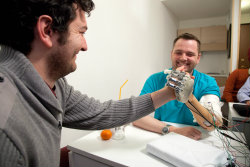NEBIAS: The world’s most advanced bionic hand
Researchers have created a new neural interface to provide sensory information from an artificial hand to the brain. This interface is able to link the patient’s nervous system with the artificial sensors, embedded in the prosthesis, enabling the user to control complex hand and finger movements. Mr Sørensen, whose hand was amputated ten years ago, has been participating in the project’s experiments, ‘They gave me a baseball to hold and for the first time in a decade I could feel I was holding something round in my prosthetic hand.’ To make it possible for Mr Sørensen to feel the shape of the object he was holding, the researchers first had to develop a selective, implantable neuro-interface. ‘Selective means, for example, that when I’m talking to you in a crowd, I’m not talking to a guy sitting close to you. In other words, the electrodes have an interface with some areas of the nerves and not with others close by,’ explains project coordinator Dr Silvestro Micera . Micera and his team enhanced the artificial hand with sensors that detect information about touch, which is sent in real time to the patient, allowing for the natural control of the hand. With the prototype passing its initial tests with flying colours, the next stage is to identify two or three people to test the prosthesis over some years, with all the elements being portable, wearable or implanted. If that works, in five or six years from now the final stage would be a large-scale clinical trial to establish if the prosthesis can be used widely. Dr Micera firmly believes the prosthesis will be available in ten years time. Necessity of long-term funding NEBIAS is a continuation of intensive multi-disciplinary research in this field which started many years ago with the CYBERHAND Future and Emerging Technologies (FET) FP5 Project (2002-2005). While CYBERHAND was able to demonstrate a mechanical hand, the task of direct interfacing to the nervous system to enable natural control proved to be beyond the project's reach. Efforts to connect robotic artefacts to the nervous system were pursued notably under FP6 and FP7, with successful testing of a prototype electrode without sensory feedback and investigation on how electrodes could be implanted into a patient's nerve. The sensory feedback challenge was overcome only recently, and NEBIAS, also an FET funded project, is now fully exploiting the prosthesis and further developing the technology to bionic arms. Building on the results of successive projects allows to overcome the various challenges and to refine the technology, resulting in ground breaking innovation that may well enhance the lives of amputees across Europe and beyond. Innovation through collaboration This multi-disciplinary research brought together researchers from materials, computer and neuro-sciences, biomedical microtechnology and electronic engineering. Over these different EU funded projects, scientists from 29 different institutions, involving 7 EU countries (and even a participation from USA) worked together with just one goal – to make a prosthetic hand that can enable natural sensation and motion. ‘This is one of the things I love about the EU,’ says Dr Micera. ‘These transnational projects are amazing. You can draw on a pool of over 500 million inhabitants to find the best researchers in different fields.’ NEBIAS, also, was launched at the start of November 2013 and will run for four years. It receives EUR 3.4 million from the European Commission’s 7th Framework Programme . Link to project's website Digital Agenda For Europe Links to related videos/audios: Video
Keywords
Robotics, prosthesis, hands, arms, limbs, neuroscience, engineering, information technology, FET, EU, CORDIS, FP7



